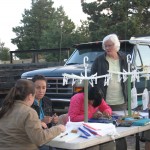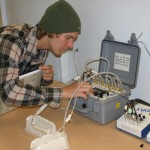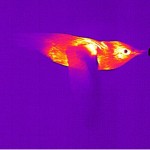
Katie (far left), Mexican interns, and Dr. Susan Wethington working the banding table and DLW experiment.
Don Powers along with research students Katie Langland and Luke Andrew traveled to various areas in southeastern Arizona to begin data collection on the lab’s NASA-funded project exploring how climate change might impact hummingbird populations and their distribution. The primary goals for this summer’s work were to 1) complete some basic metabolic measurements for an upcoming paper on how broad-tailed hummingbirds (Selasphorus platycercus) were impacted by two extreme cold events over the past several years, 2) begin collection of infrared thermography data and make metabolic measurements that will help the lab understand how hummingbirds respond to changes in their thermal environment, and 3) develop protocols for measuring daily energy expenditure over a variety of thermal conditions using the doubly-labeled water technique. During our time in Arizona we had the opportunity to work with four student interns from Mexico who are contributing to other aspects of the NASA project led by lab collaborator Dr. Susan Wethington. These interns were bright, talented, and a joy to work with. I am considering supporting a Mexican intern next summer that will focus on your physiological studies and work closely with the labs research students.
Overall the field season was success. Now the hard work of analysis begins. Katie returns to Oregon today (July 8) and the entire lab will meet tomorrow to set analysis goals for the rest of the summer. Needless to say we will all be very busy! While the lab gets a respite from field work Don Powers will make multiple short trips back to Arizona in late August and September for more DLW work as there are a few more wrinkles that need to be ironed out before next year’s longer field season (April-September). Let the fun begin!
The slide show below shows a few pictures from our time in Arizona. Click here to see the complete photo album of our Arizona adventure.
No photos available right now.
Please verify your settings, clear your RSS cache on the Slickr Flickr Admin page and check your Flickr feed









